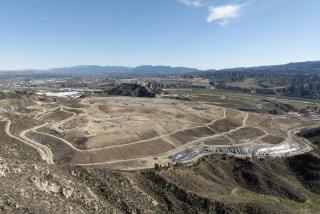BKK, Residents Reach Accord on Dump Lawsuits
- Share via
A tentative settlement has been reached between the BKK Corp. and 507 neighbors of the company’s West Covina dump, who had sought $100 million to $150 million to compensate them for alleged health, safety and other problems related to the dump.
Because of a court order agreed to by both sides, neither the attorneys for the dump nor the residents would reveal the dollar amount or any other details of the proposed settlement, reached earlier this month.
The accord, which covered 13 separate suits, caps more than five years of litigation and resolves nearly all of the damage suits related to the BKK dump that have been filed against the company, according to Rene Tatro, an attorney for BKK.
Catherine Graham, part of the legal team representing the homeowners, would say only that the settlement satisfies the vast majority of the homeowners involved.
‘Responsibility and Fairness’
“BKK has displayed a great deal of responsibility and fairness,” Graham said. “We feel everything has worked to everyone’s satisfaction.”
As to the size of the settlement, she said, “This case involves 507 people. I think that speaks for itself.”
Tatro said BKK was pleased with the settlement, adding, “The fact that BKK was willing to settle is a reflection of its social conscience. My client has devoted a great deal of time and energy to doing the right thing.”
Tatro added that the other defendants in the 13 suits, including the original owner of the landfill, Home Savings & Loan Assn., are included in the settlement.
One of the plaintiffs, Alan Kunihiro, who had to evacuate his home in July, 1984, after authorities discovered explosive levels of methane gas seeping from the landfill, said he is happy that a settlement has been reached.
He said he did not know how much he will receive from BKK or if homeowners had to make any concessions as part of the agreement. “But just to get this behind us and get on with life, I would be willing to accept a settlement,” he said.
Kunihiro said he hopes each homeowner will receive at least as much as what he and 164 other residents got last May when they reached a $5.25-million out-of-court settlement with W & A Builders, the company that built the homes next to the dump.
“The money I got from the builders covered my loss in the value of my home” he said. “Whatever I get from BKK is the icing, so to speak.”
Lingering Suspicions
Kunihiro added there is a lingering feeling in the neighborhood that despite the accord, a final victory may still be years away.
“I’ve come now to the point where I’m not looking for any quick solutions,” he said. “It’s taken seven years to get to where we’re at, and I wouldn’t be surprised if this dragged on for another 10 or 15 years.”
Graham, who worked with attorney Herbert Hafif in representing the homeowners, said there still are details to work out before the settlement is final and the homeowners may have to go to court to get some of their money from BKK’s insurance companies.
She said some of the insurers are disputing the amount of their liability and further negotiations will be needed to decide who pays what.
Willing to Pay
But she added that several companies have said they are willing to pay their fair share and she expects the homeowners may receive some payment within 90 days.
She said the settlement does not affect children under 18, who could still sue the company in the future for alleged BKK-related problems.
“We did not represent the children and that is a separate consideration,” Graham said.
Tatro said there are only two remaining homeowner suits involving 10 to 20 people that are still unresolved.
BKK took over the landfill off Azusa Avenue in the San Jose Hills area in the early 1960s and began depositing hazardous waste at the 583-acre landfill in 1968.
Over the years, homeowners have complained that the landfill has generated widespread fear and driven down housing prices in the area.
The public outcry against the dump grew steadily from 1980 to 1984, when BKK was the primary dump for hazardous waste from throughout Southern California.
During that time, residents would show up at City Council meetings carrying signs dubbing the city “Waste Covina” and “Toxic Capital of the U.S.,” and ask the city to close the dump.
Forced Evacuation
Despite the complaints, the company did not stop its disposal of hazardous waste there until July, 19, when 21 families were evacuated from the area after explosive levels of methane gas were found near their homes. The state also found high concentrations of vinyl chloride, a carcinogen.
Since that time, the level of outrage has subsided. A West Covina City Council hearing six months ago on whether to ban housing construction near the dump because of potential health hazards was dominated by speakers for developers. Only a few residents spoke or even bothered to attend.
But concern over the landfill, which accepted more than 3.4 million tons of hazardous waster between 1968 and 1984, continues.
State health officials earlier this year advised the West Covina City Council to impose a moratorium on residential construction within 2,000 feet of the dump’s toxic waste area.
And BKK has taken steps to control potential hazards related to the landfill.
Stopping Leakage
The gas leakage into residential neighborhoods has been stopped by a gas collection system that burns off the gas or routes it to a 5-megawatt electrical generating plant that supplies power to 5,000 homes, said BKK President Ken Kazarian.
The area also is monitored by probes drilled around the site.
Leakage of hazardous fluids is being controlled by a collection system that runs the fluid through air stripper towers that draw off volatile organic compounds and funnel them to burners, Kazarian said.
The landfill still accepts household trash, but the company has agreed to stop all dumping at the site by 1995. The closure, including construction of a hazardous-fluid purification plant, will cost an estimated $13 million, Kazarian said.
More to Read
Inside the business of entertainment
The Wide Shot brings you news, analysis and insights on everything from streaming wars to production — and what it all means for the future.
You may occasionally receive promotional content from the Los Angeles Times.










